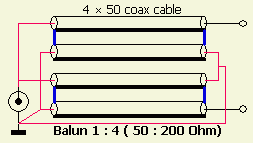|
Indoor 1 : 4 balun (33 µH)
Turns ratio. |
|
COAX BALUN 1 : 4, CONSTRUCTION AND USE
|
Indoor 1 : 4 balun (33 µH)
Turns ratio. |
|
BALUN 1 ÷ 4

An air wound balun made with coaxial cable can not saturate because no powdered iron or ferrite core is used. The system consists of two equal lengths of coaxial cable (fig»). On the one side in parallel and on the other side in series. If one use 50 Ω or 75 Ω coaxial cable the transformation ratio is respective 25 Ω : 100 Ω and 37.5 Ω: 150 Ω.
If you want a precise 50 Ω : 100 Ω ratio, then two pieces of 100 Ω coaxial cable are required.

Eventually you may take four equal lengths of 50 Ω and then connect two to two in parallel and so that two pairs of 100 Ω (fig ») arise. Then the pairs are connected in parallel at the start and in series at the end.
Incidentally, a transfer ratio of 1 ÷ 4 only exist if there is a real resistive impedance (no + j or-j) of the correct value is provided.
Balancing for different complex impedance remains good, but it is even possible that a down transformation instead of an up transformation occurs. This balun is only suitable only for an asymmetric balanced tuner with a symmetric load such as dipole or open line to an antenna.
See the example:


FD4
A simple but still effective way of feeding an FD4 is a single 1 ÷ 4 balun and an ATU. Most often the SWR then is less than 2 ÷ 1, which an ATU in or near the transceiver can handle without appreciable losses. That avoids the somewhat difficult task of making a 1 ÷ 6 or 1 ÷ 7 transformer. On the lower bands, a 1 ÷ 4 balun provides a lower SWR than a 1 ÷ 6 or 1 ÷ 7 transformation.
In this case 75 Ω coaxial cable may be used.
![]()